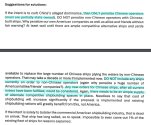You are using an out of date browser. It may not display this or other websites correctly.
You should upgrade or use an alternative browser.
You should upgrade or use an alternative browser.
Chinese shipbuilding industry
- Thread starter tphuang
- Start date
The purpose of the proposed rules are not meant to bring shipbuilding back to the US. The true purpose is to damage China’s shipbuilding industry.Public comments to the USTR proposal to charge fees on Chinese ships continue to trickle in. This comment by Hans Laue of Gisholt Shipping is perceptive.
View attachment 147457View attachment 147458View attachment 147459View attachment 147460View attachment 147461
by78
General
The navigation bridge section of Adora Flower City has been joined to the hull, which is now around 95% complete.


Status update: the shipwide ventilation system of Adora Flower City has come online.

Long report about Chinese shipyards and their exemplary role in military-civil fusion. Considering that it was published by CSIS, the quality is surprisingly not that bad. I did get a chuckle out of the policy recommendations, which carefully note that the US can't do very much by itself and maybe Trump might want to get some help from other countries instead of picking stupid fights.
Plenty of focus on CSSC, as one would expect.
Plenty of focus on CSSC, as one would expect.
At the heart of Beijing’s MCF ambitions in shipbuilding lies the China State Shipbuilding Corporation (CSSC), an expansive conglomerate of shipyards, factories, and research institutes overseen by China’s top political and military leadership. CSSC is the world’s largest shipbuilding group, and in 2024 alone, it produced more commercial vessels by tonnage than the United States has since World War II. Yet, the company is also responsible for building warships for the ever-expanding People’s Liberation Army Navy (PLAN), which is rapidly amassing the world’s largest fleet.
China State Shipbuilding Corporation is the world’s largest shipbuilding conglomerate by both revenue and market share. It boasts 84 subsidiaries and employs over 200,000 people across shipbuilding, marine engineering, research and development, and various other portfolios. The firm calls itself the “main force” in developing China’s naval forces, and “undertakes the scientific research and production tasks of all the main combat equipment of the Chinese Navy.”8 Similar to U.S. firms like Boeing or Lockheed Martin, it is a major defense contractor with significant commercial operations. However, CSSC has fewer lines separating its commercial and military operations, creating inherent risks for companies seeking to do business without inadvertently contributing to China’s military development. In 2020, the U.S. Department of Commerce placed 25 CSSC subsidiaries on its Entity List, restricting the transfer U.S. technology to those entities.9 In 2021, the U.S. Department of the Treasury added the company to its Non-SDN Chinese Military-Industrial Complex Companies List, restricting certain financial transactions with the firm.10
escobar
Brigadier
Preliminary signs of a two-tier freight market emerge as US crackdown on Chinese-built tonnage nears
Initial industry reaction suggests that the market contemplates an increase in freight rates, a substantial diversion in traffic towards Mexican ports, and a cancellation of some newbuilding contracts at Chinese yards,
COSCO reported their 2024 financials today. Highlights include big gains in operating revenue (+33%), earnings before interest/taxes (91%) and net profit (+95%). It's worth noting that many shipping companies had a good year, thanks to sustained demand and the Houthis.






